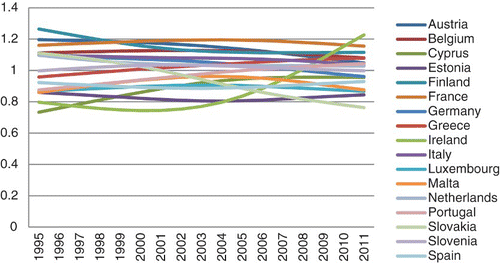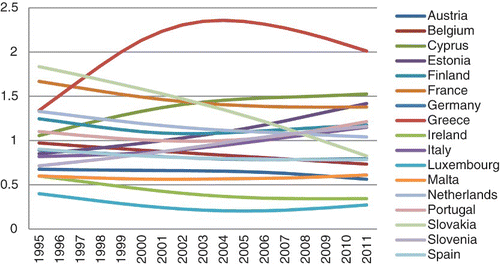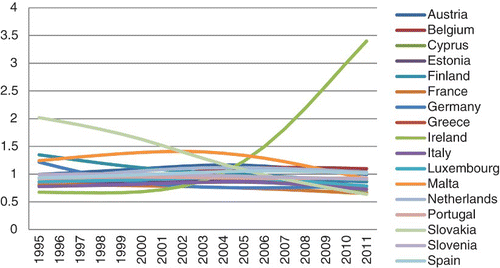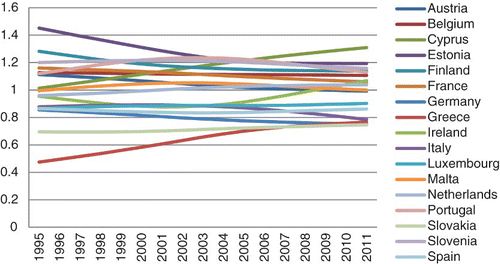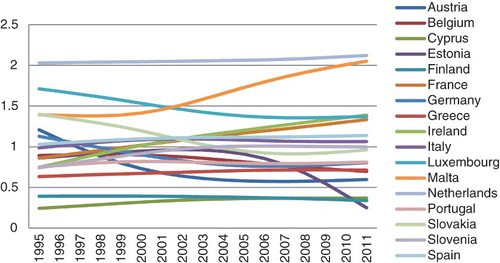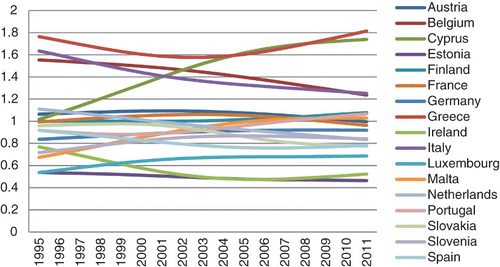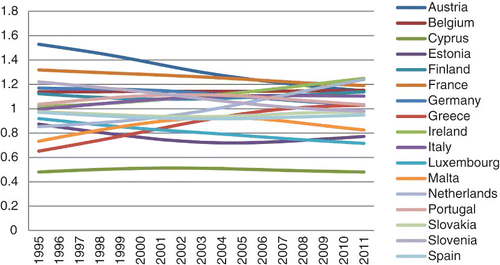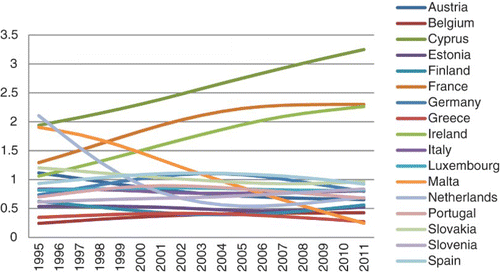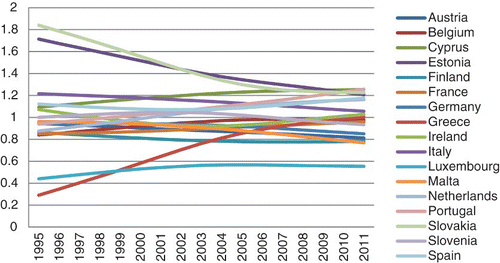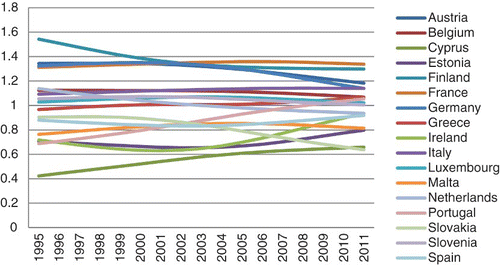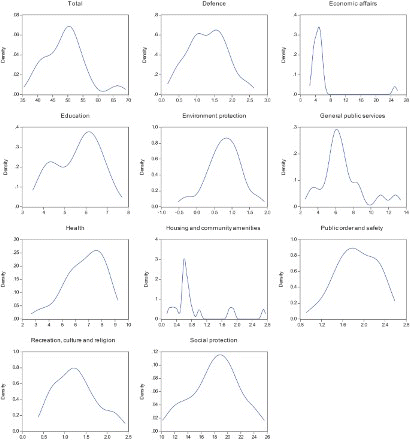Abstract
The goal of the present article is to investigate the degree of convergence in public expenditures for a panel of 17 European Union member countries spanning the period 1990 to 2012. We apply the methodology of Phillips and Sul (Citation2007) to various categories of public expenditures to assess the existence of convergence clubs. Overall, the results do not support the hypothesis that all countries converge to a single equilibrium state in various public expenditures.
I Introduction
Fiscal policy has been characterized by its objective to create a sound economic environment via the reduction or the removal of fiscal imbalances that give rise to low inflation and helps the stabilization of the real economy through the well-functioning of built-in stabilizers. However, governments might pursue objectives in addition to economic growth, such as welfare maximization, provision of public goods and redistribution (Xie et al., Citation1999). With respect to the distribution of public expenditures, this is a highly important issue for social cohesion, sustainable development and as an indicator of the rational distribution of welfare. In particular, economic progress has been largely paid for by an increasing inequality within certain country groups, i.e. Asian tiger economies and the celebrated Celtic Tiger, indicating the dual role that public expenses are called to play to maintain a sustainable growth path process (Powell andBarrientos, Citation2004). They also argue that another dimension through which public expenses can alleviate the burden of not symmetric growth is through the implementation of active labour market policies that will drive people back to the labour markets, while Cook and Kwon (Citation2007) support that the role public expenses play to support the well-functioning of the institutional political system that aims to provide solid sustainable policies to the growth process. At the same time, inequalities and divisions within an economy as well as the recent financial and economic crisis tend to increase the risk of political instability, which, in turn, disrupts the growth process. These characteristics denote that the pendulum has swung excessively far in the direction of laissez faire across a number of countries. In this respect, public expenses come to protect social cohesion which is considered a source of wealth and high economic performance, i.e. health, education, through the need to provide social services (Rose, Citation2000; Ritzen, Citation2001). In particular, a strand of the literature examines the effect of public expenses on the provision of public education and they exemplify their role through the increases participation in social and labour activities (Poterba,Citation1997; Alesina et al., Citation1999). For the case of the European countries, the role of public expenses with respect to the reduction of welfare disparities and financial equalization between wealthier and poorer countries is highly required in promoting the growth process and economic convergence (Follesdal, Citation2001). Finally, in terms of sustainable development, public spending also comes through environmental protection, which calls for proper treatment, especially during periods of financial difficulties and in terms of assignment, allocative and productivity efficiencies (Gupta, Citation1995).
Europe's ratio of government spending to Gross Domestic Product (GDP) is historically high, primarily because of social security expenses. However, the critical question is whether it will be possible for such high ratios to be sustainable in the long-run. At the same time, the European Monetary Union (EMU) and in terms of economic policy implementation, requires the member countries to implement an orthodox strategy of macroeconomic policy that downgrades fiscal policy. This strategy is based on a theoretical (neoclassical) background according to which fiscal policy cannot affect economic growth in the long-run and it can have real effects only in the short-run, correcting cyclical disequilibria (Alesina et al., Citation2002; Briotti, Citation2005; Kumar et al., Citation2007). Nevertheless, the Lisbon Strategy and the reformed Stability and Growth Pact accept the potential positive impact that fiscal policy can have on real economy even in the long-run, an impact that is attributed to the composition of public expenditures (Deroose and Kastrop, 2008). Furthermore, the development of the public-policy endogenous growth models provides supportive evidence to the fact that the economic growth is substantially determined by the accumulation of productive factors as well as by technical progress (Barro and Sala-i-Martin, Citation1995; Jones, Citation1995; Angelopoulos et al., Citation2006).
In that sense, particular items from public expenditures, such as expenses on research & development, education and health defence, tend to generate positive externalities to the economy, thus, promoting the goal of economic growth (Afonso and Gonzalez-Alegre, Citation2008). In the past, different European countries organize their public spending in different ways, allocating key categories to different subsectors. However, following the formation of the European Union (EU), governments realized that they can join forces and integrate services, processes, systems and resources to coordinate their fiscal efforts in order to satisfy a number of economic and noneconomic targets. Based on these observations, a convergence in national fiscal policies has been expected, especially in the size of spending, both in total terms and across its components. The analysis in this strand of the literature provides mixed results, with a number of studies supporting the hypothesis of convergence (Sanz and Velazquez, Citation2004) and others supporting the absence of such convergence (Starke et al., Citation2008).
Moreover, the importance of the quality of public expenditure is also highlighted since a government could increase public spending by a large amount but this does not mean that it would have an effective result on economic and social development. It is the quality of this spending that also matters since some expenses have no impact on economic growth, so it is important to investigate which types of public spending are being carried out effectively. Spending on retirement, for example, has a different nature from spending on education and health, so one has to define the different categories of public expenses. According to Afonso et al. (Citation2005), there are some public spending categories that are essential for the performance of economy. This ‘productive’ spending may be as important to growth as private capital and labour. Thus, we can define quality of public expenditure as a mix of a well-distributed budget and application and smart public policies that affect economic growth as well as people's lives more efficiently.
The goal of this empirical study is to investigate for the first time and with an updated data sample whether public spending differences across euro countries decrease or increase through a convergence approach. It is known that euro countries continue to have considerable discretion over their fiscal measures, and in order for them to fully and in real terms integrate to a single currency area, they need to satisfy one of the most controversial criteria set by the Maastricht Treaty, the so-called the Stability and Growth Pact. According to the Pact, budget deficits are expected not to exceed 3% of their respective GDP, signalling a message to the governments to reduce their role in the economy and to leave more space for the more productive private investments. Public expenditures, both on an aggregated and on a disaggregated manner, provide an indication of how economies prioritize certain public expenditures functions are associated with economic growth and promote broad-based changes in living standards. Moreover, the composition of public expenditures could provide clear documentation about the efficacy of certain social policy categories (Hindriks and Myles, Citation2006), given the number of critics arguing that they hamper dynamic growth since they cost more than they yield, rendering them unsustainable, while they foster lower productivity and moral hazard.
A first empirical attempt for the European countries originated from Afxentiou and Serletis (Citation1996), at a time where the euro project was at a preliminary stage of design and the potential event of a fiscal sovereign crisis was unthinkable. Given the new euro environment, however, as well as the recent fiscal sovereign crisis, we strongly believe that the examination of the current picture regarding public expenditures convergence is more than a necessity. The findings will be highly important, not only to the direction of public expenditures in order to guide long-run economic growth, but also for the design of efficient public policies on a euro scale. They can also be the basis for more realistic policy recommendations that can be put forward, in an effort to eliminate such differences within the euro area.
An additional novelty of this article stems from the implementation of the new methodology of panel convergence testing, recommended by Phillips and Sul (Citation2007). The philosophy of the methodological approach is based on the club convergence hypothesis, suggested by Fischer and Stirbock (Citation2004), which considers that certain countries, states, sectors or regions, that belong to a club move from disequilibrium positions to their club-specific steady-state positions. This methodology has several appealing characteristics. To begin with, no specific assumptions concerning the stationarity of the variable of interest and/or the existence of common factors are necessary. This convergence test could be interpreted as an asymptotic cointegration test without suffering from the small sample problems of unit root and cointegration testing. In addition, the methodology is based on a quite general form of a nonlinear time-varying factor model.
The rest of the article is organized as follows. Section II reviews the recent empirical literature on public expenditures convergence. Section III presents the new methodology employed. Section IV reports and discusses the results of the empirical analysis, while Section V summarizes the article and offers some policy implications.
II The Literature
The literature so far stresses the joint course of growth and fiscal convergence, by presenting models that do not separate explicit predictions of long-run growth effects and public expenditures effects. Barro (Citation1990) and Barro and Sala-i-Martin (Citation1992) employ models – within a standard Ramsey framework – in which the growth prospects of a country are interrelated with the way fiscal policies are implemented. Within the same framework, Bleaney et al. (Citation2001) estimate the impact of public expenditures on economic growth, for a number of EU countries. Their results signify that only the ‘productive’ parts of public expenditures seem to matter for economic growth.
In a different strand of the literature, that exemplifies the β- and σ-convergence approaches, Sanz and Velazquez (Citation2004) explore the presence of convergence by focusing entirely on the structure of government expenditures for a number of Organization of Economic, Cooperation and Development (OECD) countries. Their empirical results indicate strong divergence patterns across their country sample, yielding a number of barriers to a single convergence group. In neoclassical growth theories, convergence tests the tendency of a specific country's output to move towards its own steady state under specific assumptions. Beta convergence provides a suitable testing method for convergence within an economy. Binder and Pesaran (Citation1999), however, question the adequacy of β-convergence regressions. They show that β-convergence, even when used to study the growth path of a given economy towards its own steady state, can collapse in the case of a stochastic technological progress. Durlauf et al. (Citation2005) note that a negative coefficient (β) on initial income in a cross-sectional framework could simply imply that economies converge to their own different steady states, while Pesaran (Citation2006) argues that by definition, β-convergence refers to convergence within an economy.
According to σ-convergence, a group of economies converges if the cross section variance of the per capita output decline across time. Friedman (Citation1992) and Cannon and Duck (Citation2000) propose regression specifications to test for σ-convergence. As Bliss (Citation1999, Citation2000) notes, however, the underlying assumption of an evolving data distribution introduces difficulties in the interpretation of the test distribution under the null. Moreover, the rejection of the σ-convergence hypothesis does not necessarily mean that economies do not converge; transitional dynamics in the data can cause the rejection of the null hypothesis of σ-convergence. Critics of σ-convergence argue that it provides a necessary, but not sufficient, ingredient for observing reductions in real per capita income dispersion (Friedman, Citation1992; Quah, Citation1993). If countries converge to a common equilibrium with shared global technologies and identical internal structures, then the dispersion of income should disappear in the long-run as all countries converge to the same real per capita income. If, however, countries converge to convergence clubs or to their own unique equilibrium, the dispersion of real per capita income will not approach zero. Moreover, in the latter case of country-specific equilibrium, the movements of the dispersion will depend on the initial distribution of real per capita incomes relative to their final long-run outcomes (Miller and Upadhyah Citation2002).
Researchers in convergence define club convergence as the tendency of out per capita across countries to converge to multi steady-state equilibria, one for each basin of attraction. The empirical literature on the detection of convergence clubs employs a variety of statistical methods. Durlauf and Johnson(Citation1995) dismiss the frequently used linear model that studies cross country economic behaviour in favour of multiple regimes, using a data set of 121 countries. They reject convergence in real per capita income, while using regression tree analysis; they find evidence for club convergence in multiple steady states. Quah (Citation1993, Citation1996, Citation1997) proposes the distributional dynamics approach to study convergence. He examines the convergence clubs hypothesis by viewing the evolution of the entire distribution over time. He finds that the income distributions evolve from a unimodal ‘one peak’ distribution towards bimodal ‘twin peaks’ distribution. Hansen (Citation2000) uses a threshold regression to sort the countries into different regimes and provides evidence to support such multiple regimes, while Canova(Citation2004) proposes a new technique for grouping converging countries in terms of real per capita income. His methodology implies that countries exhibit multiple steady states for real per capita income. He finds that the steady-state distribution income for European regions clusters around four different poles, while that for the OECD countries clusters around two different poles. Phillips and Sul (Citation2003) argue that cross section divergence is possibly a transient phenomenon since economies may exhibit transitional divergence in their way towards a common steady state. They make use of a new methodology to test for club convergence and examine three different samples for convergence in per capita output. Their results for the US sample indicate that the transition paths for every state appear to converge. The results for the OECD sample indicate divergence in terms of per capita output until World War II. Around 1950, however, this pattern changed and the transition paths of per capita output appear to converge. Finally, the results from the Penn World Tables sample indicate that although per capita output diverges across countries, strong evidence exists for the presence of converging subgroups (i.e. club convergence). The Phillips and Sul(Citation2007) clustering procedure allows the endogenous determination of convergence clubs by leaving factors unspecified that might lead to their formation.
In the empirical growth literature, the majority of empirical studies refer to convergence as the tendency of narrowing the output gap across countries. In this line, Bernard and Durlauf (Citation1995, Citation1996) give the first formal definition of cross country convergence. Their statistical definition states that two countries converge if their long-term forecasts are equal. According to their definition, two countries converge if their output gap is a zero mean stationary process. Pesaran (Citation2006) argues that the Bernard–Durlauf convergence definition requires identical economies in all respects. He proposes a general probabilistic definition of convergence and suggests using a pair-wise approach to test for output convergence across countries. According to Pesaran's definition, two countries converge if their output gap is a stationary process. Given the empirical regularity that output series are usually I(1) processes, cointegration and unit root procedures can test for convergence. Bernard and Durlauf (Citation1995, Citation1996) point out that cointegration (or unit root) tests are appropriate for testing convergence, if countries are near their steady state. Therefore, if outputs converge but are not near their steady state, cointegration (or unit root) tests tend to reject the null of convergence. Although their results indicate that per capita real incomes do not converge, they find evidence for the presence of a group of long-run factors that jointly determine output growth for the countries under investigation. The use of cointegration and unit root tests for testing output convergence are subject to a number of serious drawbacks. First, these tests fail to detect convergence when more than one equilibrium exists. In the growth literature, theoretical and empirical evidence exists of the possibility of club convergence. In Azariadis and Drazen's (Citation1990) theoretical growth model multiple steady-state equilibriums can appear. Hobijn and Frances (Citation2000) and Durlauf and Johnson (Citation1995) provide empirical evidence in favour of the presence of convergence clubs across countries. Second, if the countries converge but the data come from a time of transitional dynamics, cointegration and unit root tests cannot identify the tendency to converge. Third, suppose that two countries converge to the same steady state and they are also near the steady state. If the output data combine steady state and transitional data, which seems reasonable given that the Summers–Heston data spans at most 57 years, then empirical testing for convergence using cointegration and unit roots tests may lead to misleading results. To study convergence of both transitional dynamics and long-run behaviour requires a model in a consistent framework. Unfortunately, standard testing methodologies for output convergence do not account for both regularities and, thus, they do not suitably test real economic convergence. Durlauf et al. (Citation2005) argue that growth econometrics as an area of research is still in his infancy and they point out the need for new econometric methodologies for testing the convergence hypothesis. New methods are needed to evaluate the growth paths over time as well as the long-run convergence across economies.
Phillips and Sul (Citation2007) propose a new powerful econometric methodology for testing whether a panel of economies tends to converge to a common steady state. The proposed methodology (for more technical details refer to the next section) allows for a wide range of transition paths as well as for transitional divergence. The authors argue that if a panel of economies fails to converge, this does not preclude the presence of convergence subgroups (clubs) within the panel. They introduce a clustering procedure to identify endogenously the convergence clubs (if any). The new methodology is not tied to growth theories and can be used to study convergence in economic and financial variables beyond output. Most importantly, the proposed clustering procedure identifies endogenously the presence of multiple equilibria and is able to detect any convergence clubs even in the absence of multimodality. The presence of multiple equilibria does not necessarily manifest itself as multimodality. Furthermore, as was pointed out by Silverman (Citation1986), such hypotheses as unimodality and multimodality are too broad to ensure high power. Additionally, the presence of multimodality cannot ensure club convergence since such interpretation also requires an analysis of the mobility within the distribution.
III Econometric Methodology
In this section, we outline the methodology proposed by Phillipsand Sul (2007) (henceforth PS) to test for convergence in a panel of countries and to identify any convergence clubs. PS propose a new econometric approach for testing the convergence hypothesis and the identification of convergence clubs. Their method uses a nonlinear time-varying factor model and provides the framework for modelling transitional dynamics as well as long-run behaviour. Furthermore, their statistical methodology can test for convergence in economic variables other than output.
The new methodology adopts the following time-varying common-factor representation for yit of country i:
The goal of PS is to test whether economic variables yit, i=1, 2, …, N, tend to converge to a single steady state as t→∞. To this direction they adopt a factor representation (Equation (1)) for each economic variable in the sample. The factor μt is assumed common across individuals (economies), while the transition dynamics are captured by the idiosyncratic components δit which are allowed to vary across cross section and time. Convergence is a dynamic process. Since δit trace out the transition paths, convergence can be tested by examining the temporal relative evolution of δit. PS do not assume any parametric form for μt; they just factor it out and they concentrate on δit.
Since we cannot directly estimate δit from Equation (1) due to over-parameterization, i.e. the number of parameters is greater than the number of observations, PS assume a semi-parametric form for δit, which enables them to construct a formal test for convergence. In particular, they eliminate the common component μt through rescaling by the panel average:
The empirical convergence literature also deals with the possible existence of multiple equilibriums. In that case, rejection of the null hypothesis that all countries in the sample converge does not imply the absence of convergence clubs in the panel. In this study, we implement the club convergence and clustering procedure proposed by PS. We summarize that procedure as follows: (1) order the N countries with respect to the last-period value of the time series. For example, in the case of GDP per capita, we order the countries in a descending order with the first country having the highest last-period income, the second with the next highest income and so on; (2) Form all possible core (club) groups Ck by selecting the first k highest countries, with k=2, 3, … , N. Then, test for convergence using the log tk test within each subgroup of size k. Finally, define the core club C* of size k* as the club for which the maximum computed statistic occurs, given that the log tk statistics supports the convergence hypothesis; (3) from the remaining N−k* countries, add one country at a time to the core club C* and test for convergence through the log t test. If the test strongly supports the convergence hypothesis (
, then include the country to the group C*. Find all countries that, according to the log t test, converge to the same steady state with the core group C*; these countries together with the countries of the core group C* form the first convergence club in the panel; (4) then, for the remaining countries (if any), repeat the procedure described in steps 1–3 to determine the next convergence club, if one exists. Finally, terminate the procedure when the remaining economies fail to converge.
IV Empirical Analysis and Results
Data
The OECD provides a breakdown of government expenses according to purpose. Therefore, quarterly data on a number of public expenditure classifications as a percentage share of GDP, such as total, defence, economic affairs, education, environment protection, general public services, health, housing and community amenities, public order and safety, recreation,{} culture and religion and social protection – all measured as percentages of their corresponding GDP – for a number of EU countries, are obtained from the Datastream database spanning the period 1990–2012. All public expenditures and GDP are measured at 2000 constant prices.
Regression results
Some studies of time series convergence have raised certain concerns about the validity of the econometric results in the case time series exhibits structural breaks (see among others, Li and Papell,Citation1999). Before applying the PS methodology, we test for the presence of structural breaks with unknown timing by employing the Max Wald F-test proposed by Andrews (Citation1993).Footnote5 The results reported in show that the null of no breakpoints is strongly supported for the majority of cases. Specifically, at the 5% significance level, less than 6% of the time series appear to undergo a structural change, while at the 1% significance level the percentage of time series that may exhibit a break is reduced to 3%. Since the breakpoint test results suggest that most of the time series do not undergo structural changes, we proceed to apply the PS methodology.
Table 1. Tests results for the presence structural breaks
reports the results of the panel convergence methodology for total public expenditures as a percentage of total GDP. The first row reports the results of testing full convergence (i.e. convergence among all sample EU countries), while rows two and three display the results of the club clustering procedure. The results of the full sample reject the null hypothesis of public expenditures convergence, since the point estimate of the log t statistic is −8.978 (with the critical value equal to −1.645). The formation of the two different convergence clubs shows that there exist two groups of countries, with 15 and 2 countries, respectively. The relative level of convergence in terms of the overall public expenditures indicates stronger interdependencies of economic strategies with respect to fiscal policy, while the economies involved are shown to have more similar productive structures. Nevertheless, the absence of full convergence indicates that there exist idiosyncratic factors in each member country, such as preferences, political and institutional factors, which maintain a different public expenditures distribution.
Table 2. Total public expenditures
report the convergence results for defence, economic affairs, education, environment protection, general public services, health, housing and community amenities, public order and safety, recreation, culture and religion and social protection expenditures. As before, the top of the tables report the convergence results for the entire sample. The convergence club algorithm identifies two clubs for health and public order and safety expenditures, three clubs for defence, economic affairs, recreation, culture and religion, social protection and housing and community amenities (plus a nonconverging club) expenditures and, finally, four clubs for education, environmental protection and general public services expenditures, thus yielding support to the presence of divergence across public expenditures categories.
Table 3. Defence expenditures
Table 4. Economic affairs expenditures
Table 5. Education expenditures
Table 6. Environment protection expenditures
Table 7. General public services expenditures
Table 8. Health expenditures
Table 9. Housing and community amenities expenditures
Table 10. Public order and safety expenditures
Table 11. Recreation, culture and religion expenditures
Table 12. Social protection expenditures
In terms of and with reference to the defence expenses, the empirical findings indicate the presence of three converging groups. This type of expenses has been a significant item in total GDP across countries within the sample (with the exception of Luxemburg and Ireland, two countries that belong to the same converging group). Given the strong link between defence expenses and economic growth, this explicit pattern of convergence is also indicative for the corresponding growth pattern. A large number of empirical works have generated results associated with both the impact of defence expenses on economic growth and on convergence issues (Dunne et al., Citation2005; Mylonidis, Citation2008; Pieroni, Citation2009, among others). Dunne et al. (Citation2005) offer a neoclassical framework on the defence–growth nexus by adopting the convergence framework of the economic growth set-up and provide empirical support to the presence of convergence irregularities with respect to defence expenses across a large number of countries. Aizenman and Glick(Citation2006) also argue that divergence between defence expenses and growth patterns indicates similar patterns for skilled labour, productive capital and educational forms. Finally, Bayraktar-Saglamand Yetkiner (2012) argue that the presence or not of convergence in defence expenses is an indication of the assumed constant and identical growth rate across countries. Therefore, our results point out the absence of a unified convergence pattern due to differentiated technological changes, i.e. R&D expenses and the share of human capital allocation across our country sample.
Public expenditure on economic affairs covers support programmes, subsidies and public infrastructure spending in the mining, manufacturing, agricultural, energy, construction, transport, communication and other service industries. The empirical results of show that in terms of public spending on economic affairs, this component of spending is characterized by a nonconverging pattern across the EU countries. This picture of the lowest levels of public expenditures is rather disappointing given the Article 87 of the EU Treaty on any type of aid granted to activities that eliminate distortions of competition and trade transactions and the radical Common Agricultural Policy (CAP) reformed package adopted in 1992. The findings recommend that the EU member countries should accomplish a convergence pattern for this type of public expenses and then to redirect public resources towards increasing capital accumulation, R&D expenses and information technologies.
Education is a priority area of public policy and a central element in the drive to make Europe an effective competitor in a globalized economy. The findings of also display a nonconverging picture in terms of educational expenditures. The recommendations here are that the European economy needs long-term investment in human capital to convergence this component of public spending and, thus, to maximize productivity. Such investment should be closely related to greater innovation and specialization in higher value-added activities, which through multiplier effects, will contribute to further economic growth. Furthermore, the nonconverging picture highlights that although over the period under study a great number of EU countries have experienced a wave of approaches to restructuring the education sector based on the New Public Management (NPM) principle, i.e. higher efficiency, decentralization, search of excellence, internationalization, marketization and public service orientation, these efforts have interacted with traditions, ideologies, institutions and politics that have prevented the harmonization or convergence of public expenses on education (Alexiadou and Jones, Citation2001). At the same time, differences in fiscal regulation and legislation relative to decision-making either within educational entities or on a regional level also contribute to the same results. Finally, the divergence pattern revealed in could also be associated with the convergence process of human capital and growth patterns across the EU countries. In other words, the picture indicates that in an open economy, the dynamics of public expenses on education could be the driving force of growth. Overall, from an economic policy perspective, our findings in emphasize the key role of public expenses on education convergence in growth convergence and, thus, governments have a role to play in promoting a harmonized EU policy towards public spending.
Nowadays, the business-government landscape clearly highlights a good opportunity for both business and governments to shape the future and, in particular, a sustainable development future since climate change is a very strong pressure that affects overall business strategies and public policies, while sustainable development documents the field of synergies between the two parties. Public policies act through laws, policies and voting initiatives, to work out the solutions for sustainable development, solutions that are related to regulatory programmes, projects on energy efficiency, pollution prevention and eco-efficiency. Although the EU has enacted several directives with important environmental implications, the results of clearly demonstrate that convergence in public policies in the EU related to environmental protection are far from being a reality. The presence of four convergence clubs indicates divergence not only towards public environmental policies, but also towards sustainability. Therefore, it is crucial that such public expenses policies are better coordinated so as to support common regulatory requirements as well as innovative firms that invest in greener products and to set metrics to track growth processes. In this manner, public expenses policies are expected to move to the next level of environmental protection strategy and to shape a new way of manufacturing that will go beyond controlling pollution.
shows the convergence results relative to the general public expenses that include expenses associated with the executive and legislative bodies, expenses related to the operation and management of the Ministries of Finance and Foreign Affairs, the operation and management of social planning and staffing services, procurements, the maintenance of public facilities, transfer payments and election expenses. The findings in display the absence of convergence (i.e. the presence of four different club groups) of this category of public expenses, denoting the need the EU to give greater weight to strengthen existing coordination mechanisms about the expenses that contribute to the most to the presence of high public deficits and public debts, since governments appear to have high degrees of freedom to use this category of public expenses to serve their own political interests.
In terms of , health spending also displays a nonconvergence picture, indicating that member countries should pay higher attention to lead this component to a convergence model. The reason is that well-functioning health systems can facilitate higher efficiencies and production, since ill-functioning health systems are very costly, very unproductive and nonsustainable. The convergence of health spending could increase economies of scale in public budget management and making the overall European economy more efficient.
Housing and community amenities expenses have the potential to be valuable marketing tools, especially, for rural communities. Housing developments built in association with amenities promote community income, help bring new families to communities and stimulate growth. Infrastructure costs are an investment, not an expense. Communities should carefully consider their return on that investment, while increased taxes from such a type of public expenses might bring a greater return on the community's investment. The empirical findings in show the presence of three different convergence clubs, while two countries, i.e. Greece and Cyprus, form a nonconverging club. The recommended policies out of the divergence results should lead to the creation of an EU vision for ongoing major public investment in such related amenities that is connected to broader goals of environmental protection, regional and overall growth, and other infrastructure investments. Such policies should lead to incentives to coordinate EU and regional infrastructure planning. The EU area will need legislative and policy changes to better inform, encourage and provide guidance for the largely regional practices of planning new housing (i.e. new school facilities) amenities. EU public policies should do more than just encourage regional countries – governments to include housing amenities in their short- and long-range comprehensive plans. Regional policies should establish incentives to strategically align their planning. If EU countries coordinate their plans, opportunities will arise for all to reduce costs by locating housing amenities near existing infrastructure, by creating joint uses, and by identifying opportunities to reinvest in urban assets; thus, offering new opportunities for meeting regional environmental goals.
reveals that public expenses on public order and safety display a stronger convergence picture once the empirical analysis identified two convergence clubs. Although the EU is not characterized by a federalist type of political organization, the empirical finding supports that a number of attempts to coordinate policies associated with public order and safety have generated successful outcomes. Nevertheless, the implementation of such public policies is not considered a type of productive investment and a number of researchers recommend the reduction of such public expenses (Cullison, Citation1993; Glass, Citation2009).
Government expenses on recreation, culture and religion include administration of sporting, recreational and cultural affairs as well as the maintenance of zoos, botanical gardens, public beaches and parks, the support for broadcasting services and, where present, support for religious, fraternal, civic, youth and other social organizations (including the operation and repair of facilities and payment to clergy and other officers). In addition, such expenses include grants to artists and arts companies, capital outlays such as the construction of sports stadiums, public swimming pools, national theatres, opera houses and museums. The results in show again the absence of full convergence and the presence of three distinct clubs. This category of expenses is considered a type of nonproductive fiscal policy and the literature has long recommended the reduction of these expenses in favour of other categories (Miyakoshiet al., Citation2010). The separation identification of this component of fiscal expenses between private and public consumption allows the efficiency of public intervention to strictly depend on a correct use of this instrument in choosing alternative economic policies. For these reasons, this separation issue becomes an important policy variable, which should be taken into account when the optimal level of government expenses on goods and services is being determined.
An empirical analysis (IMF, 1995) shows that social protection is generally the main public expenses item across the EU. Spending on social protection is a very clear way to gauge the level of government intervention in the economy and it is related to a commitment to ameliorate distributional inequities and to protect people from the risks of the marketplace. The results in show the presence of three convergence clubs, yielding that EU member countries have taken a different approach in terms of their social protection expenses public policies contributing heavily to the presence of public deficits and public debts and depriving resources away from more growth oriented public policies, such as education and health expenses, since such policies generally cost more than they yield, they give rise to work disincentives, suffer from moral hazards and, thus, hinder economic productivity. Therefore, a better coordination EU strategy is needed to lower the cost of those policies implementation, which will enhance not only fiscal, but also overall efficiency.
Relative transition curves results
As it was pointed out in the methodology section, transitional time paths are captured by the dynamic factor loadings delta, δit, which cannot be estimated due to over-parameterization. Following Phillips and Sul (Citation2007), we alternatively estimate the relative transition measures, hit, defined in Equation (2), which capture the transition paths with respect to the panel average. display the relative transition curves for the number of classes of public expenses under study. Visual inspection of these figures suggests the absence of full convergence, but does not preclude club convergence. Quah (Citation1993, Citation1996, Citation1997) suggests that multimodality of the distribution can be interpreted as evidence of club convergence. Although, the proposed PS clustering procedure identifies endogenously the presence of multiple equilibria and is able to detect any convergence clubs even in the absence of multimodality, as a pretest we provide kernel density plots across the 17 EU countries of our sample for 2011 (). A visual inspection of these plots highlights the fact that the majority of densities cannot be viewed as unimodal. Additionally, we have also employed a formal test statistic, the dip-test (Hartigan and Hartigan, Citation1985) to examine the validity of the null hypothesis of unimodality against the alternative of multimodality. The results reported in suggest that at the 10% significance level, the null of unimodality is rejected across all public expenses, with the environment protection expenses being the only exception.
Table 13. Unimodality tests
V Conclusions
It has been true that the quality of government policy tends to affect the level of economic growth as well as the economic welfare of people. The scope of this study was to investigate the convergence of government expenditures as percentages of GDP across the selected EU countries, spanning the period from 1990 to 2012. Convergence was examined not only with respect to total expenditures, but also with respect to a number of public expenditures categories.
In terms of total public expenditures, the results point to the presence of a quite uniform convergence group, implying the presence of similar groups, implying that the EU countries have paid higher attention only to the overall figures of public expenditures. For disaggregated public expenditures, however, the empirical findings displayed less convergence, as characterized by more convergence clubs. The EU countries form specific groups, characterized by individual factors that determine the idiosyncratic course of their own path for public expenditures. The empirics just confirm that these countries appear to have chosen dissimilar paths for their public expenditures measures.
In addition, the analysis of the composition of total expenses displayed the absence of convergence in both productive and nonproductive public expenses components. This result exposes signs that the government spending of RS has not been carried out effectively towards a greater economic development. This also reflects the severe public finance crisis that RS has passed, leading to the decrease in spending in areas that may boost physical and human capital and thus greater economic development. These empirical findings recommend that these countries should start paying higher attention to the composition as well as to the quality of public finance; thus, strengthening the presence of productive expenditures as well as their economic growth future. In addition, public agents have the challenge to make public expenses more efficient by speeding up the convergence process for the productive size of public expenses, generating the greatest economic growth possible; thus, benefiting the whole population. This task, however, is extremely complex. Further studies still must be developed to support managers in the decision-making process of allocating public spending to engender economic growth, enhancing quality of life and the well-being of citizens. This study attempted to contribute in this issue, since public spending should be performed as effectively as possible, always seeking to improve the living standard of population. Given the recent debt sovereign crisis in the European territory, we cannot ignore the need for the euro countries to design either a more coordinated European fiscal policy or to implement a federal fiscal policy; thus, rendering the event of future fiscal sovereign crises less prevalent.
Acknowledgements
We thank the comments made by a referee that enhanced substantially the quality of an earlier draft. We also thank Donggyu Sul for making the Gauss code available to us. A sample code can be downloaded from Donggyu Sul's homepage: http://homes.eco.auckland.ac.nz/dsul013/. Needless to say, the usual disclaimer applies
Notes
1In this paper, we set .
2Appendix B of PS reports the analytic proof under the convergence hypothesis for this regression equation.
3Following the recommendation of PS, we choose r-values in the interval [0.2, 0.3].
4The log t test exhibits favourable asymptotic and finite sample properties.
5The PS methodology is semi-parametric, while it is robust to different forms of transitional dynamics and does not fall in the category of classical time series convergence tests. Consequently, we expect that it would behave relatively well in the presence of structural breaks.
References
- Afonso, A., Erbert, W., Schucknect, L. and Thöne, M. (2005) Quality of public finances and growth, ECB Working Papers Series, No. 438, European Central Bank, Frankfurt.
- Afonso, A. and Gonzalez-Alegre, J. (2008) Economic growth and budgetary components: a panel assessment for the EU, Working Paper Series, No. 848, European Central Bank, Frankfurt.
- Afxentiou, P. C. and Serletis, A. (1996) Government expenditures in the European Union: do they converge or follow Wagner's Law, International Economic Journal, 10, 33–47.
- Aizenman, J. and Glick, R. (2006) Military expenditure, threats, and growth, Journal of International Trade and Economic Development, 15, 129–55. doi: 10.1080/09638190600689095
- Alesina, A., Ardagna, S., Perotti, R. and Schiantarelli, F. (2002) Fiscal policy, profits and investment, American Economic Review, 92, 571–89. doi: 10.1257/00028280260136255
- Alesina, A., Baqir, R. and Easterly, W. (1999) Public goods and ethnic divisions, Quarterly Journal of Economics, 114, 1243–84. doi: 10.1162/003355399556269
- Alexiadou, N. and Jones, K. (2001) Travelling policy/local spaces, Paper presented at the Congress Marx International, Paris.
- Andrews, D. W. K. (1993) Tests for parameter instability and structural change with unknown change point, Econometrica, 61, 821–56. doi: 10.2307/2951764
- Andrews, D. W. K. and Ploberger, W. (1994) Optimal tests when a nuisance parameter is present only under the alternative, Econometrica, 62, 1383–414. doi: 10.2307/2951753
- Angelopoulos, K., Economides, G. and Kamman, P. (2006) Tax-spending policies and economic growth: theoretical predictions and evidence from the OECD, European Journal of Political Economy, 23, 885–902. doi: 10.1016/j.ejpoleco.2006.10.001
- Azariadis, C. and Drazen, A. (1990) Threshold externalities in economic development, Quarterly Journal of Economics, 105, 501–26. doi: 10.2307/2937797
- Barro, R. (1990) Government spending in a simple model of endogenous growth, Journal of Political Economy, 98, 103–17. doi: 10.1086/261726
- Barro, R. and Sala-i-Martin, X. (1992) Public finance in models of economic growth, Review of Economic Studies, 59, 645–61. doi: 10.2307/2297991
- Barro, R. and Sala-i-Martin, X. (1995) Economic Growth, McGraw Hill, New York.
- Bayraktar-Saglam, B. and Yetkiner, H. (2012) A Romerian contribution to the empirics of economic growth’, IEU Working Paper Series. Available at http://eco.ieu.edu.tr/working-papers/ (accessed 15 February 2013).
- Bernard, A. and Durlauf, S. (1995) Convergence in international output, Journal of Applied Econometrics, 10, 97–108. doi: 10.1002/jae.3950100202
- Bernard, A. and Durlauf, S. (1996) Interpreting tests of the convergence hypothesis, Journal of Econometrics, 71, 161–73. doi: 10.1016/0304-4076(94)01699-2
- Binder, M. and Pesaran, M. H. (1999) Stochastic growth models and their econometric implications, Journal of Economic Growth, 4, 173–83. doi: 10.1023/A:1009802421114
- Bleaney, M., Gemmell, N. and Kneller, R. (2001) Testing the endogenous growth model: public expenditures, taxation and growth over the long-run, Canadian Journal of Economics, 34, 36–57. doi: 10.1111/0008-4085.00061
- Bliss, C. (1999) Galton's fallacy and economic convergence, Oxford Economic Papers, 51, 4–14. doi: 10.1093/oep/51.1.4
- Bliss, C. (2000) Galton's fallacy and economic convergence: a reply to Cannon and Duck, Oxford Economic Papers, 52, 420–2.
- Briotti, M. G. (2005) Economic reactions to public finance consolidation: a survey of the literature, Occasional Paper Series, No. 38, European Central Bank, Frankfurt.
- Cannon, E. S. and Duck, N. W. (2000) Galton's fallacy and economic convergence, Oxford Economic Papers, 52, 415–9. doi: 10.1093/oep/52.2.415
- Canova, F. (2004) Testing for convergence clubs in income per capita: a predictive density approach, International Economic Review, 45, 49–77. doi: 10.1111/j.1468-2354.2004.00117.x
- Cook, S. and Kwon, H. J. (2007) Social protection in East Asia, Global Social Policy, 7, 223–9. doi: 10.1177/1468018107078165
- Cullison, W. (1993) Public investment and economic growth, Federal Reserve Bank of Richmond Economic Quarterly, 79, 19–33.
- Deroose, S. and Kastrop, C. (2008) The Quality of Public Finances, European Economy, Occasional Papers, No. 37, European Commission, Directorate-General for Economic and Financial Affairs, Brussels.
- Dunne, J. P., Smith, R. and Willenbockel, D. (2005) Models of military expenditure and growth: a critical review, Defence and Peace Economics, 16, 449–61. doi: 10.1080/10242690500167791
- Durlauf, S. and Johnson, P. (1995) Multiple regimes and cross-country growth behavior, Journal of Applied Econometrics, 10, 365–84. doi: 10.1002/jae.3950100404
- Durlauf, S. N., Johnson, P. A. and Temple, R. W. (2005) Growth econometrics, in Handbook of Economic Growth, Vol. 1 (Eds) P. Aghion and S. N. Durlauf, Elsevier, Amsterdam, pp. 136–52.
- Fischer, M. M. and Stirbock, C. (2004) Regional income convergence in the enlarged Europe, 1995-2000: a spatial econometric perspective, ZEW Discussion Paper No. 04-42, ZEW Institute, Manheim.
- Follesdal, A. (2001) Citizenship: European and global, ARENA Working Paper, No. 01/22, ARENA, Oslo.
- Friedman, M. (1992) Do old fallacies ever die?, Journal of Economic Literature, 30, 2032–2129.
- Glass, A. (2009) Government expenditure on public order and safety, economic growth and private investment: empirical evidence from the United States, International Review of Law and Economics, 29, 29–37. doi: 10.1016/j.irle.2008.07.006
- Gupta, R. (1995) Public expenditure policy and the environment: a review and synthesis, World Development, 23, 515–28. doi: 10.1016/0305-750X(94)00139-P
- Hansen, B. E. (1997) Approximate asymptotic p-values for structural-change tests, Journal of Business and Economic Statistics, 15, 60–7.
- Hansen, B. E. (2000) Sample splitting and threshold estimation, Econometrica, 68, 575–603. doi: 10.1111/1468-0262.00124
- Hartigan, J. A. and Hartigan, P. M. (1985) The dip test of unimodality, The Annals of Statistics, 13, 70–84. doi: 10.1214/aos/1176346577
- Hindriks, J. and Myles, G. D. (2006) Intermediate Public Economics, The MIT Press, Cambridge.
- Hobijn, B. and Frances, P. H. (2000) Asymptotically perfect and relative convergence of productivity, Journal of Applied Econometrics, 15, 59–81. doi: 10.1002/(SICI)1099-1255(200001/02)15:1<59::AID-JAE544>3.0.CO;2-1
- International Monetary Fund. (1995) Unproductive public expenditures: a pragmatic approach to policy analysis, Pamphlet Series, No. 48, IMF, Washington, DC.
- Jones, C. I. (1995) R&D models of economic growth, Journal of Political Economy, 103, 759–84. doi: 10.1086/262002
- Kumar, M. S., Leigh, D. and Plekhanov, A. (2007) Fiscal adjustments: determinants and macroeconomic consequences, Working Paper, No. WP/07/178, International Monetary Fund, Washington, DC.
- Li, Q. and Papell, D. (1999) Convergence of international output: time series evidence for 16 countries, International Review of Economics and Finance, 8, 267–80. doi: 10.1016/S1059-0560(99)00020-9
- Miller, S. M. and Upadhyay, M. P. (2002) Total factor productivity and the convergence hypothesis, Journal of Macroeconomics, 24, 267–86. doi: 10.1016/S0164-0704(02)00022-8
- Miyakoshi, T., Kono, T. and Terasawa, K. (2010) Optimal adjustment of the composition of public expenditure in developing countries, Pacific Economic Review, 15, 577–95. doi: 10.1111/j.1468-0106.2010.00518.x
- Mylonidis, N. (2008) Revisiting the nexus between military spending and growth in the EU, Defence and Peace Economics, 19, 265–72. doi: 10.1080/10242690802164801
- Pesaran, H. (2006) A pair-wise approach to testing for output and growth convergence, Journal of Econometrics, 138, 312–55. doi: 10.1016/j.jeconom.2006.05.024
- Phillips, P. C. B. and Sul, D. (2003) The elusive empirical shadow of growth convergence, Cowles Discussion Paper #1398, Yale University, New Haven, CT.
- Phillips, P. C. B. and Sul, D. (2007) Transition modeling and econometric convergence tests, Econometrica, 75, 1771–855. doi: 10.1111/j.1468-0262.2007.00811.x
- Pieroni, L. (2009) Military expenditure and economic growth, Defence and Peace Economics, 20, 327–39. doi: 10.1080/10242690701589876
- Poterba, J. M. (1997) Demographic structure and the political economy of public education, Journal of Policy Analysis and Management, 16, 48–66. doi: 10.1002/(SICI)1520-6688(199724)16:1<48::AID-PAM3>3.0.CO;2-I
- Powell, M. and Barrientos, A. (2004) Welfare regimes and welfare mix, European Journal of Political Research, 43, 83–100. doi: 10.1111/j.1475-6765.2004.00146.x
- Quah, D. (1993) Galton's fallacy and tests of the convergence hypothesis, The Scandinavian Journal of Economics, 95, 427–43. doi: 10.2307/3440905
- Quah, D. (1996) Twin peaks: growth and convergence in models of distribution dynamics, The Economic Journal, 106, 1045–55. doi: 10.2307/2235377
- Quah, D. (1997) Empirics for growth and distribution: polarization, stratification and convergence club, Journal of Economic Growth, 2, 27–59. doi: 10.1023/A:1009781613339
- Ritzen, J. (2001) Social cohesion, public policy and economic growth: implications for OECD countries, in The Contribution of Human and Social Capital to Sustained Economic Growth and Well-Being: International Symposium Report (Ed) J. F. Helliwell, Human Resources Development, Manila, pp. 36–54.
- Rose, R. (2000) How much does social capital add to individual health? A survey of Russians, Social Science and Medicine, 1, 1–15.
- Sanz, I. and Velazquez, F. J. (2004) The evolution and convergence of the government expenditure composition in the OECD countries, Public Choice, 119, 61–72. doi: 10.1023/B:PUCH.0000024162.20553.8e
- Silverman, B. W. (1986) Density Estimation for Statistics and Data Analysis, Chapman and Hall, London.
- Starke, P., Obinger, H. and Castles, F. G. (2008) Convergence towards where: in what ways, if any, are welfare states becoming more similar, Journal of European Public Policy, 15, 975–1000. doi: 10.1080/13501760802310397
- Xie, D., Zou, H. and Davoodi, H. (1999) Fiscal decentralization and economic growth in the United States, Journal of Urban Economics, 45, 228–39. doi: 10.1006/juec.1998.2095
